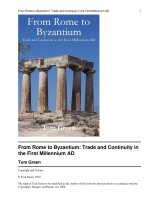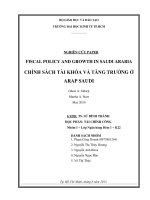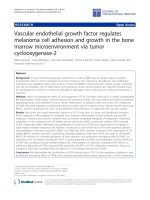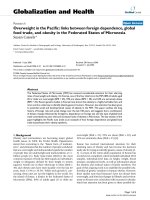trade and growth in thailand
Bạn đang xem bản rút gọn của tài liệu. Xem và tải ngay bản đầy đủ của tài liệu tại đây (127.42 KB, 13 trang )
1
Trade and Growth in Thailand, 1950-2000
(This is the first draft, no citation without permission from the authors)
Duc Minh Nguyen
Auburn University & Nong Lam University
Henry Thompson
Auburn University
April 2008
The present paper using time series analysis examines the link between trade and growth in Thailand
from 1950 to 2000 in an applied growth model including capital and the exchange rate as control
variables. Prior to 1980 the elasticity of per capita income with respect to trade was -0.2% switching to
0.07% in 1980 in line with the change from resource exports and import substitution to manufactured
exports. The exchange rate elasticity of per capita income prior to 1980 was 0.4% switching to -0.2%
consistent with the move to a floating exchange rate. Results confirm the overriding theoretical
importance of investment to economic growth.
Keywords: international trade, neo-classical growth, time series analysis, Thailand
JEL code: F43, O53
Contact author: Duc Minh Nguyen, Department of Economics, 202 Comer Hall, Auburn University AL
36849, 334-844-4800, fax 334-844-5639
2
Trade and Growth in Thailand, 1950 - 2000
The role of trade in economic growth is a recurring issue, and countries exporting manufactures
seem to grow faster than those exporting natural resource products. Thailand presents an interesting
study with its market economy discussed by Yamada (1998) as the share of agriculture in GDP fell from
37% in 1961 to 13% in 1991. Nevertheless, labor intensive agriculture still employs the majority of the
labor force and receives the third largest government budget allocation.
From agricultural base, Thailand has become one of the more diversified economies in Southeast
Asia (The Economist, 2004).
Import substitution policy of the 1970s switched to manufactured export
promotion in the 1980s based on labor intensive products such as textiles and apparel. Since 1990 the
fastest growth has been in high technology products such as computer accessories and motor vehicle
parts. Industrial growth is based on imports of capital goods, intermediate goods, raw materials, and
fuels. This half century of varied growth provides a laboratory to examine the empirical links between
trade and growth. The present paper examines trade and growth in Thailand during the last half of the
20
th
century.
1. The literature and present model
Regarding the evidence on trade and growth, Karras (2003) investigates data for 161 countries
and finds trade has a positive, permanent, and sizable effect on growth. Panagariya (2004) finds
sustained rapid growth cannot be achieved without rapid trade growth. Rassekh (1992) shows that
poorer countries increase their trade faster than high income countries and faster trade expansion implies
more rapid growth across 19 OECD countries. Deme and Homaifar (2001) find a long run positive
relationship between imports and growth for Japan. Olufemi (2004) uncovers a unidirectional
relationship between trade and growth for Nigeria and shows the effect depends on the level of
economic development.
In contrast, Levine and Renelt (1992), Sala-i-Martin (1997), and Masters and McMillan (2001)
find trade has not been a robust determinant of recent economic growth. Lutz (2001) uncovers only a
3
weak and inconsistent link for industrialized countries. Dowrick and Golley (2004) find specialization
in primary exports slows growth with the benefits of trade going mostly to developed countries since
1980.
Ades and Glaeser (1999), Frankel and Romer (1999), Alesina, Spolaore, and Wacziarg (2000,
2003), and Frankel and Rose (2002) find access to larger export markets fosters growth, and Alcalá and
Ciccone (2003) find trade matters more for smaller economies. In an analysis of 55 developing
countries, McCarthy, Taylor and Talati (1987) find trade is not related to growth for developing
countries with commodity trade surpluses offsetting imports of capital goods and services. Frankel and
Cavallo (2004) find trade makes countries less vulnerable to sudden stops and currency crashes.
The present model examines the impact of a trade index, total trade relative to income, on per
capita income. The trade index is export revenue plus import spending relative to gross domestic
product. The exchange rate is included as a control variable to isolate its impact. The capital labor ratio
is the foundation of neoclassical economic growth and is included as a control variable.
Start with the neoclassical production function, y = Ak
α
where y ≡ income per worker, k ≡
capital labor ratio, and 0 < α < 1. The shift variable A = φT
β
e
γ
is a function of the trade index T ≡ (X +
M)/Y and the exchange rate e ≡ bath/$.
In log linear form lny = lnA + αlnk = lnφ + βlnT + γlne + αlnk and the empirical specification is
lny
t
= a
0
+
a
1
lnT
t
+ a
2
lne
t
+ a
3
lnk
t
+ ε
t
(1)
where ε
t
is a stochastic error term. Coefficient a
3
is the capital share of output and expected to be
positive and less than one. There are no a priori expectations about the signs of a
1
and a
2
.
2. Stationarity analysis
The 51 annual observations from 1950-2000 are from Penn World Table 6.1 of Heston,
Summers, and Aten (2001). Trade is in current prices, the 1996 USD value of the sum of exports and
imports divided by GDP as in Ades and Glaeser (1999), Frankel and Romer (1999), Alesina, Spolaore,
4
and Wacziarg (2000), and Frankel and Rose (2002). Capital is derived as accumulated investment
starting with 1950 investment as the capital stock that year. Time plots are in Figure 1.
* Figure 1 *
Stationarity tests are reported in Table 1. The variables are not stationary in autoregressive
(AR1) models. The variable lnk is not difference stationary in the augmented Dickey-Fuller (ADF) test.
The F-value in the ADF model is larger than the critical φ statistic (5.61) and lnk is not a random walk
but the white noise residual from the ADF model resk
t
= dlnk
t
- 0.50dlnk
t-1
qualifies for regression
analysis.
* Table 1 *
The variables lnY and lnT are difference stationary with in DF models with white noise
residuals. Variable lne is not difference stationary, does not pass the ADF test, and cannot be detrended
because residuals do not have constant variance. Transformed to the double ln form, lnlne is not
stationary but is difference stationary in the DFt model with a time trend. The regression model uses
lnlne as the exchange rate variable.
In summary, lny, lnT, and lnlne are random walk integrated I(1) processes and their first
differences enter in model construction. The residual of lnk in the ADF model (resk) is used to examine
the effect of the capital labor ratio variable.
3. Model construction and estimation
As apparent in Figure 1, there is a structural break in 1980 in the exchange rate and a dummy
variable (D) is included with D = 0 for 1950-1980 and D = 1 after 1981.
In the regression, dlny is the dependent variable and dlnT, resk, and dlnlne are explanatory
variables. The variable resk is replaced by its regression resk
t
= dlnk
t
- 0.50dlnk
t-1
in the ADF model.
The empirical model is then
dlny = α
0
+ α
1
dlnT + α
2
resk + α
3
dlnlne + α
4
D + α
5
DdlnT + α
6
Dresk + α
7
Ddlnlne + ε
t
(2)
5
Regression results are in Table 2. The autocorrelation in model A0 is controlled in model A with Prais
and Winsten algorithm in Limdep.
* Table 2 *
For description, Model A is written in the two periods as
dlny
t
= 0.07 - 0.16dlnT
t
+ 1.44resk
t
+ 1.23dlnlne
t
(1950-1980) (3)
dlny
t
= 0.07 + 0.07dlnT
t
+ 1.44resk
t
- 0.65dlnlne
t
(1981-2000) (4)
Substituting dlnk
t
- 0.50dlnk
t-1
for resk
t
the derived model is
dlny
t
= 0.07 - 0.16dlnT
t
+ 1.44dlnk
t
– 0.72dlnk
t-1
+ 1.23dlnlne
t
(1950-1980) (5)
dlny
t
= 0.07 + 0.07dlnT
t
+ 1.44dlnk
t
- 0.72dlnk
t-1
- 0.65dlnlne
t
(1981-2000) (6)
General-to-specific modeling is applied to the reduced models to test respective hypotheses as in
Table 2. In model B, the hypothesis of no level or slope effect (α
4
= α
5
= α
6
= α
7
= 0) is tested and the F
test indicates rejection of this null hypothesis. The hypothesis of no level effect (α
4
= 0) cannot be
rejected in model C while the null hypothesis of no structural effect (α
5
= α
6
= α
7
= 0) is rejected in
model D ensuring the dummy variable is appropriate.
4. Results
The role of capital is confirmed with an elasticity
ε
yk
=
δlny
t
/δlnk
t
+ δlny
t
/δlnk
t
-1
= 1.44 – 0.72 =
0.72 from (5) and (6) across the structural break. Every 1% increase in the capital/labor ratio raises per
capita income by 0.72% making the estimated factor share of capital in the modified Cobb-Douglas
production function 0.72. The restriction of no capital effect (α
2
= α
6
= 0) is imposed to ensure the
effects of trade and the exchange rate are not dominated by the capital/labor ratio, a suspected dominant
variable. The F statistic 7.75 with capital restricted confirms the significant effects of trade and the
exchange rate.
Elasticities of the exchange rate and trade are derived from (5) and (6). To ensure significant
effects, general least square regression with constraints is imposed in model E with no trade effect and
model G with no exchange rate effect. The exchange rate effect is confirmed in model G with that F
6
statistic. Using the average lne during the entire period of 3.13, the elasticity of the exchange rate prior
to 1980 is 1.23/3.13 = 0.392 with dlny/dlnlne = lne*dlny/dlne = 1.23 and dlny/dlne = 1.23/lne.
Devaluation by 10% would have raised per capita income by 3.9% prior to 1980 but since then a 10%
depreciation would lower per capita income 2.1%.
These estimated exchange rate effects seem reasonable. There were two periods of high
exchange rate variation during the oil price shock of 1979-1980 and the Asian financial crisis of 1997-
1999. Devaluation in 1980 is considered a cause of the considerable increase in trade, while
depreciation was more a symptom of the financial crisis. Along with policy focusing on export
promotion in the 1980s, the structural break in 1980 is verified by the dummy variable DdlnT.
Depreciation has been thought to contribute to export recovery following the financial crisis.
Athukorala and Suphachalasai (2004) believe the growth of trade of parts and components in vertically
integrated production has weakened the exchange rate effect.
To test the effect of trade on per capita income, the restriction α
1
= α
5
= 0 is imposed with the
hypothesis of no trade effect. This hypothesis cannot be rejected with an F test in model E indicating no
effect of trade over the entire period. Looking at the two periods separately, trade had a small negative
impact prior to 1980 and a very small positive impact since then. Prior to 1980, an increase of 10% in
trade lowers per capita income by 1.6% in (5).
Prior to 1980, Thailand was a small resource based country with exports directed to larger
developed countries such as the US and Japan. Agricultural products suffered declining prices relative
to imports of capital machinery, transport goods, and crude oil. With the oil shocks of 1973 and 1979,
the net value of Thai oil imports rose from $53 million in 1970 to $685 million in 1982 and dependence
on foreign oil reached 75% in 1980. Oil imports must contribute to the negative effect of trade on
growth before 1980.
After 1980, the effect of trade changes with a 10% increase in trade raising per capita income by
0.7% consistent with the shift to manufactured exports. Although Thailand has a trade surplus in recent
7
years as shown in Figure 2, efforts to increase exports only offset increasing import demand. The terms
of trade declined steadily from 102 in 1982 to 77 in 2003 suggesting the increased export revenue only
offsets rising import prices. Adams, Ichino and Prazmowski (2000) use an energy balance model to find
that growth in Thailand is based on export promotion, with foreign earnings offsetting the cost of
imported fuel.
* Figure 2 *
Vohra (2001) finds exports have a positive impact on economic growth when a country achieves
some level of development, examining India, Pakistan, the Philippines, Malaysia, and Thailand from
1973 to 1993. Lee and Pan (2000) find little evidence of Granger causal relations from exports to GDP
in Hong Kong, Indonesia, South Korea, Malaysia, the Philippines, Singapore, Taiwan, and Thailand.
Ekanayake (1999) uses cointegration and error-correction models to confirm there is no strong evidence
of short run causality from export growth to economic growth in India, Indonesia, Korea, Malaysia,
Pakistan, Philippines, Sri Lanka and Thailand. Siddique and Selvanathan (2002) use cointegration and
Granger causality tests to examine relationships between exports, imports, and economic growth in
Thailand during 1953-1993 finding growth causes exports, imports cause growth, and exports cause
imports. These studies, however, do not include the foundation of growth theory or control for the
exchange rate as in the present paper.
The growth effect of capital accumulation is affirmed in models (5) and (6). Thai development
may have been based on capital accumulation from agriculture but Yamada (1998) finds investment
flows from agriculture have not been large. Since the 1970s the government has adopted an export
oriented policy emphasizing labor intensive light manufacturing and investment has created rural jobs.
Manufacturing has been effective in boosting the economy since the 1980s.
Marwah and Tavakoli (2004) find one fifth of capital productivity in Thailand was generated by
foreign investment from the early 1970s to 1998. Vohra (2001), Kohpaiboon (2003), and Marwah and
Tavakoli (2004) emphasize the role of foreign investment in Thailand. Imports in the present study
8
include capital goods typically linked to foreign investment. The present paper shows the importance of
investment and increased trade during the period of manufactured exports.
5. Conclusion
The theoretical role of investment and capital is confirmed by the present time series growth
model that controls for the effects of the exchange rate and trade during the last half of the 20
th
century
in Thailand. The present results call into question estimates of the links between trade and growth that
omit capital input.
The exchange rate has opposite effects on growth depending on the exchange rate regime.
Devaluation raises per capita income before 1980 under the fixed exchange rate regime but depreciation
of the floating baht since then lowers growth. Devaluation of a fixed exchange rate does not appear to
be successful in stimulating trade but depreciation of a floating exchange rate does.
Trade had a negative effect on Thai per capita income prior to 1980 during the years of a
resource based economy with import substitution policy. With the emergence of manufactured exports
since 1980 trade has had a very small positive impact growth.
9
References
Adams, F.G., Y. Ichino, and P.A. Prazmowski (2000) Economic Growth and Energy Import
Requirements: An Energy Balance Model of Thailand, Journal of Policy Modeling, 22(2), pp. 219-54.
Ades, A. and E.L. Glaeser, 1999, Evidence on Growth, Increasing Returns, and the Extent of the
Market, Quarterly Journal of Economics, 114, pp. 1025-45.
Alesina, A., E. Spolaore and R. Wacziarg, 2000, Economic Integration and Political Disintegration,
American Economic Review, 90(5), pp. 1276-96.
Alesina, A., E. Spolaore and R. Wacziarg, 2003, Trade, Growth and the Size of Countries, Harvard
Institute of Economic, Research Discussion Paper, 1995, Cambridge, MA.
Asian Development Bank, 2004, Key Indicators, online, June 2005.
Athukorala, P. and S. Suphachalasai, 2004, Post-crisis Export Performance in Thailand, ASEAN
Economic Bulletin, 21(1), pp. 19-36
Deme, M. and H. Ghassem, 2001, Openness and Economic Growth in Japan and South Korea: An
Empirical Investigation, Economia Internazionale, 54 (2), pp. 163-75.
Dowrick, S. and G. Jane, 2004, Trade Openness and Growth: Who Benefits?, Oxford Review of
Economic Policy, 20 (1), pp. 38-56.
Ekanayake, E. M., 1999, Exports and Economic Growth in Asian Developing Countries: Cointegration
and Error-Correction Models, Journal of Economic Development, 24(2), pp. 43-56
Ender, W., 2004, Applied Econometric Time Series, 2
nd
ed., John Wiley and Sons, Inc.
Frankel, J.A and E.A. Cavallo, 2004, Does Openness to Trade Make Countries More Vulnerable to
Sudden Stops, Or Less? Using Gravity to Establish Causality, NBER Working Papers, 10957, National
Bureau of Economic Research.
Frankel, J. and D. Romer, 1999, Does Trade Cause Growth? American Economic Review, 89(3), pp.
379-99.
Frankel, J. and A. Rose, 2002, An Estimate of the Effect of Common Currencies on Trade and Income,
Quarterly Journal of Economics, 117(2), pp. 437-466.
Fullbright Economic Teaching Program. 2002, Globalization, Saigon Times Daily, Dec. 23, Vietnam.
Heston, A., R. Summers, and B. Aten, 2001, Penn World Table 6.1. Universiry of Toronto Canada,
online, June 2005.
Karras, G., 2003, Trade Openness and Economic Growth: Can We Estimate the Precise Effect? Applied
Econometrics & International Development, 3(1), pp 7-26.
Kohpaiboon, A., 2003, Foreign Trade Regimes and the FDI-Growth Nexus: A Case Study of Thailand,
Journal of Development Studies, 40(2), pp. 55-69.
10
Lee, D.Y. and M.S. Pan, 2000, On Exports and Economic Growth in East Asian Countries: Linear and
Nonlinear Causality Analyses, Pennsylvania Economic Review, 9(2), pp. 66-78.
Levine, R. and D. Renelt, 1992, A Sensitivity Analysis of Cross-Country Growth regressions, American
Economic Review, 82(4), pp. 942-963.
Lutz, J.M., 2001, Growth of Industrialized Countries and Trade Openness, International Trade Journal,
15(4), pp. 429-55.
Marwah, K. and A. Tavakoli, 2004, The Effect of Foreign Capital and Imports on Economic Growth:
Further Evidence from Four Asian Countries (1970-1998), Journal of Asian Economics, 15(2), pp. 399-
413.
Masters, W. and M. McMillan. 2001, Climate and Scale in Economic Growth, Journal of Economic
Growth, 6(3), pp. 167-186.
McCarthy, F.D., L. Taylor and C. Talati
,
1987, Trade Patterns in Developing Countries, 1964–
1982, Journal of Development Economics, 27(1-2), pp. 5-39.
Olufemi, S.M., 2004, Trade Openness and Economic Growth in Nigeria: Further Evidence on the
Causality Issue, Suid-Afrikaanse Tydskrif vir Ekonomiese en Bestuurswetenskappe/South African
Journal of Economic & Management Sciences, 7(2), pp 299-315.
Panagariya, A., 2004, Miracles and Debacles: In Defence of Trade Openness, World Economy, 27(8), pp
1149-71.
Rassekh, F., 1992, The Role of International Trade in the Convergence of per Capita GDP in the OECD:
1950-1985, International Economic Journal, 6(4), pp 1-15.
Sala-i-Martin, X., 1997, I Just Ran Two Million Regressions, American Economic Review, 87(2), pp.
178-183.
Siddique, M. A. B. and E.A. Selvanathan, 2002, Export Performance and Economic Development in
Thailand, Empirical Economics Letters, 1(1), pp. 33-42.
The Economist, 2004, Country Briefings - Thailand Economic Structure, [online; cited June 2005]
Available from URL:
Thompson
,
Henry. 2001. International Economics – Global Markets and International Competition.
World Scientific Publishing Co. Pte. Ltd., Singapore.
Vohra, R., 2001, Export and Economic Growth: Further Time Series Evidence from Less-Developed
Countries, International Advances in Economic Research, 7(3), pp. 345-50.
Yamada, J., 1998, Capital Outflow from the Agriculture Sector in Thailand. Policy Research Working
Paper, 1910. The World Bank.
11
Table 1. Stationary table of variables
AR
DF
no constant
DF
constant
DF
with t
Augmented DF Detrend
a
1
value γ's t value γ's t value F value γ's t value F value γ's t value F value
lny
1.00 ± 0.006 9.26 0.51* 0.26*
ε
t
white noise
lnk
0.96 ± 0.006* 9.50 -6.79 46.06 -13.60 157.16 -0.26* 290.70
ε
t
Corr = 0.85 white noise
lnT
1.05 ± 0.03 2.15 1.65* 2.73*
ε
t
white noise
lne
1.05 ± 0.06 1.38* 0.82* 0.67* 0.01* 2.08* -0.68* 1.61*
ε
t
ARCH
t = 3.87
ARCH
t = 3.63
ARCH
t = 3.41
ARCH
t = 3.98
corr = 0.64
lnlne
1.04 ± 0.06 1.35* 0.74* 0.55* 0.42* 2.90*
ε
t
ARCH
t value = 3.6d
3
ARCH
t = 3.06
white noise
Τ
0.10
a1 + 2σ <1 - 1.61 - 2.61 - 3.18 - 3.18
Φ
0.01
7.06 7.02 9.31
*: insignificant value (in comparison to critical value) implying γ = 0 in DF models or all coefficients equal zero in F-test.
12
Table 2. Regression results
A0 A B C D E F G
Full model
Auto-correlation
corrected
No level or
structure effect
No level
effect
No structure
effect
No trade
effect
No capital
effect
No exchange
rate effect
Intercept 0.07*** 0.07*** 0.07*** 0.07*** 0.07*** 0.07*** 0.07*** 0.07***
Trade
dlnT 0.10 -0.16** -0.07 -0.16* 0.07 - -0.15* -0.12
Capital
resk 1.42* 1.44*** 1.89*** 1.44*** 1.89*** 1.43*** - 1.60***
Exchange rate
dlnlne 0.45 1.23** -0.08 1.23** -0.08 1.05** 1.48*** -
Dummy D 0.00 0.43 - - -0.00 0.00 0.01 0.00
D*T -0.09 0.23* - 0.24* - - 0.31** 0.14
D*k 0.67 0.41 - 0.41 - 0.59 - 1.01
D*e -1.14 -1.88*** - -1.87*** - -1.59** -2.62*** -
F-stat 2.81** 0.00 3.75** 2.24 7.75*** 4.23**
Models A to F are autocorrelation corrected by Prais and Winsten algorithm
* 90%, ** 95%, *** 99%
13
Figure 1. Time trend of variables
0
20
40
60
80
100
120
140
1950 1955 1960 1965 1970 1975 1980 1985 1990 1995 2000
Trade and exchange rate
0
5000
10000
15000
20000
25000
30000
35000
40000
Per caput capital and real GDP
T (%)
e (bath/$)
k($/person/year)
y($/person/year)
Figure 4. International trade of Thailand 1981-2003 (million baht) Source: ADB
-1000000
-500000
0
500000
1000000
1500000
2000000
2500000
3000000
1981 1983 1985 1987 1989 1991 1993 1995 1997 1999
Exports, fob
Imports, cif
Trade balance









